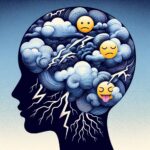The impact of depression is felt by over 1.5 million Australians every year (264 million individuals worldwide), and the early testing of depressive symptoms is more important than ever.
Table of Contents
Depression and the way we Speak
One promising avenue of depression testing might be the analysis of the way we speak. Depression doesn’t just affect our mood; it influences how we think and behave, which, in turn, affects the way we speak. People with depression often speak less fluently, using a flatter tone, or even sounding monotone.
Mental health clinicians are aware of these changes and often rely on their training to detect abnormalities in speech during clinical assessments. However, this subjective evaluation can be prone to biases and requires extensive clinical expertise. Subtle alterations in speech may also go unnoticed.
Automated speech analysis
In recent years, researchers have turned their attention to the study of specific features in speech, such as pitch, prosody (patterns of rhythm), volume, and intonation. These features go beyond just the words spoken and can serve as valuable markers for depression testing.
Individuals with depression often display irregularities in the way they speak, including reduced pitch range, slower speaking rates, and articulation errors. Some also exhibit reduced intonation and vocal monotony.
Understanding the associations between speech changes and depression can not only aid in the early testing of depressive symptoms but also inform preventive strategies and support mechanisms, especially for the younger generation facing the challenges of today’s world.
Talking about experiences
In a recent study young university students opened up about both positive and negative life events, and researchers explored whether certain speech patterns could be linked to levels of depressive symptoms.
Interestingly, people with slightly more depressive symptoms, although not clinically depressed, seemed to have a unique way of expressing themselves. They used more words when discussing both positive and negative experiences. This is contrary to what we often see in individuals with manifest depression, who tend to speak less than those without depressive symptoms.
So, why do these people with subtle signs of depression speak more? It could be because they engage in rumination or ‘mind-wandering,’ leading to an increase in verbalized thought production. Rumination is a predisposing factor that can elevate the risk of developing major depression in the future: the more we delve into the negative daily events, the more likely it will lead to depressive symptoms.
Another interesting finding was that these individuals used even more words when discussing negative events, echoing the patterns observed in individuals with depression. This might suggest that when facing a negative cue, they express themselves more extensively. Another possibility is that the increase in word count reflects a loosening of associations, perhaps compensating for distraction, cognitive slowing, or hesitancy, often signs of depressive symptoms.
Depression and the way we Draw
The study identified specific speech features that significantly contributed to predicting whether a person was above or below the depressive symptoms cut-off. An important note here, these cut-offs are always arbitrary, and we cannot simply “have” or “not have” depression, but everyone can have more or more severe symptoms of depression.
Additionally, the study found that the longer it took to complete part A of a drawing test (Trail Making Test, a test aimed at testing our attention), the higher the depression scores of the individuals were. This suggests that individuals with higher depression scores struggled more with their attention, and experienced a slowdown in information processing speed.
Interestingly, there was no such correlation in part B of the test, which assesses our executive functions (how much we can resist temptations). This could indicate that attentional deficits are among the first signs associated with depressive symptoms, while problems with executive functions tend to emerge only when depression becomes clinically significant.
In summary, indirect, computerised measurements of depressive symptoms, such as assessing the way we speak or draw simple figures, might be a good way to automate depression testing – moving away from the traditional depression quizzes.
Please note that this blog post by Personal Psychology is not intended to provide professional advice. If you or someone you know is experiencing mental health difficulties, it is important to seek help from a qualified healthcare professional.





